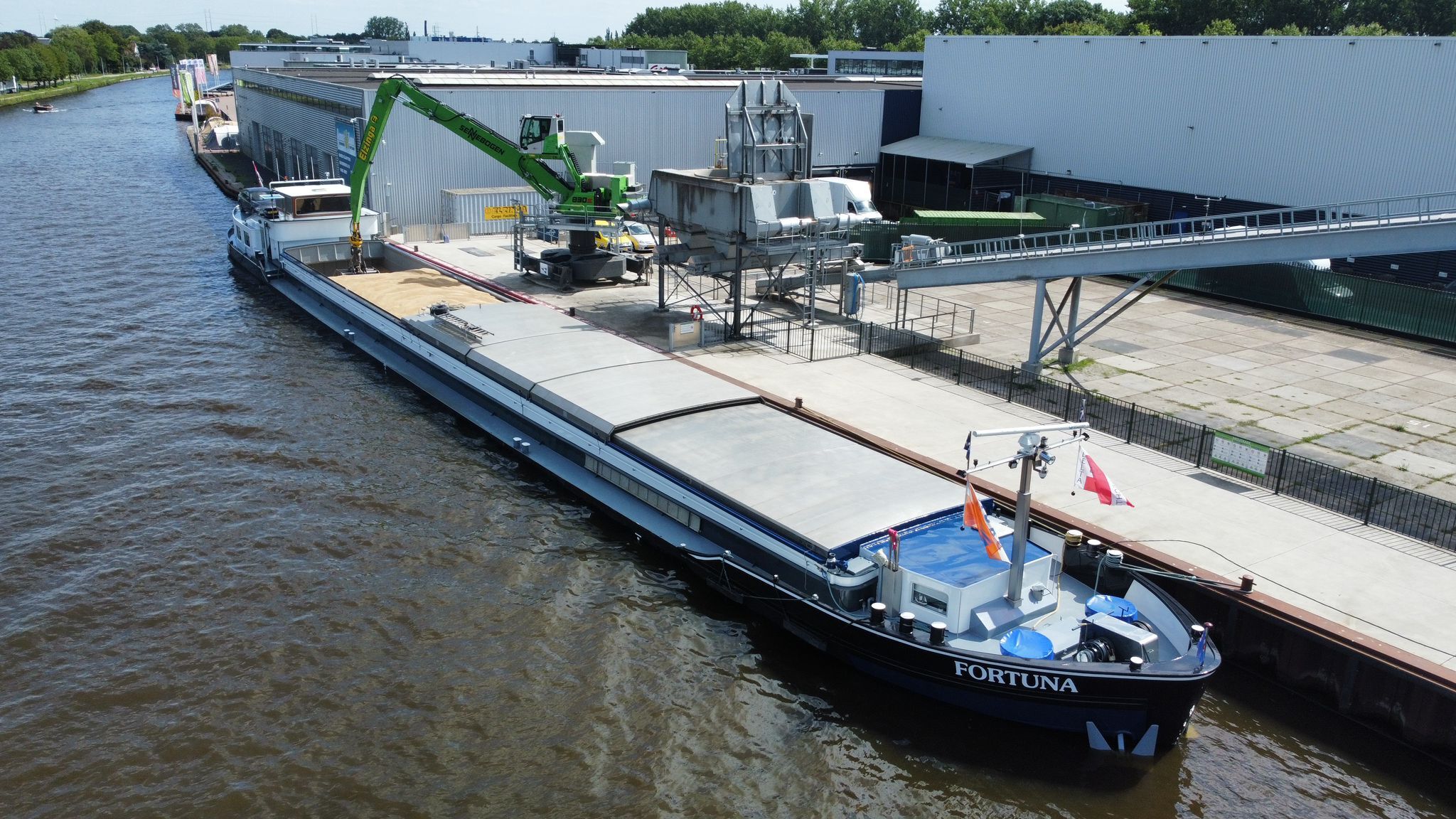PRESS RELEASE
Inland shipping emissions
increasingly monitored
Importance of CO2 calculations increases due to upcoming reporting legislation
Apart from the fact that inland shipping is already a relatively sustainable option for freight transport, the European inland shipping cooperative NPRC has set itself ambitious goals for its contribution to the targets of the climate agreement. “NPRC is a leader in the sector in the field of digitalisation and aims to become the same in the field of sustainability,” says Femke Brenninkmeijer of NPRC. NPRC has drawn up a plan of approach to make its business and logistics chain sustainable. In this plan of approach, the monitoring of emissions is extremely important, partly due to the upcoming legislation for clients.
Inland shipping transports about 31% of all goods in the Netherlands. NPRC is the largest Dutch provider of transport via inland waterways and the largest inland shipping cooperative in Europe. Every year, its 150 members transport 13 million tonnes of bulk, break bulk cargo and containers across European inland waterways.
The total emissions from Dutch inland shipping are 1.6 megatonnes of CO2 and 21.2 kilotonnes of NOx, according to the National Inventory Report. Compared to the total freight transport that includes road and rail, the proportion of inland shipping in CO2 emissions is 13% and in NOx 37%. The proportion of inland shipping in the overall CO2 emissions of the transport sector (including air freight) in the Netherlands is, at less than 5 percent, relatively low.
The EU’s climate plans contain relatively few direct measures for inland shipping. In the Netherlands, the sector has signed a Green Deal with the government to achieve a 35-50% reduction in CO2 emissions by 2035, with the ultimate aim of achieving zero-emissions in transport over water by 2050.
CSRD Regulations
These days, shippers are increasingly asking for insight into their emissions data for their own carbon accounting purposes. The forthcoming Corporate Sustainability Reporting Directive (CSRD) is expected to accelerate the demand for reliable CO2 calculations. This legislation does in fact stipulate that companies must compile a report on their CO2 emissions. Furthermore, not only their own activities will have to be included in this report, but also those of their suppliers and transporters. This will soon affect countless businesses, including shippers who make use of inland waterways.
For NPRC, this is reason enough to draw up ambitious plans in line with this development. Femke Brenninkmeijer, CEO of NPRC: “Making the logistics sector more sustainable is already far from being a trend, but a matter of course. Sustainability is now on all administrative and strategic agendas. This is an incredibly important issue for us, but certainly also for our clients.”
Digitalisation is a prerequisite for this to happen. The NPRC is therefore working closely with BigMile on CO2 monitoring to ensure that CO2 data is accredited and fit for purpose for the accountant. “If CRSD reporting is eventually linked to a carbon tax, this will open up opportunities,” adds Jan Pronk, Managing Director of software provider BigMile. “By gaining insight into the actual CO2 emissions in the chain, companies are able to take concrete action to reduce their emissions and thereby cut costs.”
“By gaining insight into the actual CO2 emissions in the chain, companies are able to take concrete action to reduce their emissions and thereby cut costs.”
Jan PronkBigMile
Business case for sustainability
NPRC uses the iBarge app to digitalise communications about shipments between ship and office. The iBarge app is linked to BigMile so that logistics service providers for inland waterway transport and barge operators can gain insight into emissions data for their own financial reports. Brenninkmeijer: “To measure is to know. If you do not make precise measurements and know how much you are emitting, then you also do not know where you can make improvements, and then any attempt at making things sustainable is a shot in the dark.”
NPRC works with barge owners and customers to reduce emissions. This can be achieved through organisational measures such as digitalisation and optimisation of the logistics process, but also through the use of alternative fuels or far-reaching technical innovations. Brenninkmeijer: “Our member Harm Lenten, who recently launched a hydrogen-electric ship that will sail on a fixed route for our client Nobian, has given us a great example of what we can do together. In this respect, it helps if inland shipping operators have a long-term relationship with the customer. If customers want to share some of the risk and co-invest in means of transport with lower emissions, then the business case for the barge owner becomes much easier.”
“To measure is to know. If you do not make precise measurements and know how much you are emitting, then you also do not know where you can make improvements, and then any attempt at making things sustainable is a shot in the dark.”
Femke BrenninkmeijerNPRC
Nitrogen
As a result, inland shipping is slowly but surely becoming more aware of its environmental impact and, in particular, its climate emissions. “This is a good development, but there is still room for raising more awareness,” Brenninkmeijer finds. Nitrogen emissions are also increasingly a topic of discussion, especially when it comes to the supply of building materials and workboats for projects that cannot go ahead at the moment because of nitrogen. “We therefore want to expand the monitoring of CO2 emissions to include NOx in the near future,” Brenninkmeijer notes.
Green Deal on Maritime and Inland Shipping and Ports
As a sustainable transport sector, inland shipping has set out its ambitions to reduce its emissions into the atmosphere in the Green Deal on Maritime and Inland Shipping and Ports. The goals and measures are aimed at reducing nitrogen and particulate matter as well as reducing CO2 emissions. The aim is to achieve a (practically) emission-free and climate-neutral inland shipping sector by 2050 and, as an intermediate step:
- By 2030, reduce CO2 emissions from the Dutch inland shipping fleet by 40% to 50% compared to 2015.
- By 2035, to have reduced emissions of environmentally polluting substances from inland navigation by 35% to 50% compared to 2015
There are more opportunities for decarbonisation in inland shipping than in international maritime shipping. Inland shipping vessels are generally much smaller than deep-sea and ocean-going vessels. Journeys are shorter than international maritime shipping, and inland shipping vessels have more opportunities to refuel or recharge.
Scope of Dutch inland shipping
Ninety percent of everything that consumers buy arrives by sea and is largely delivered and dispatched across Europe via inland shipping. The Dutch inland shipping fleet, comprising some 6,500 vessels ranging in tonnage from 350 to 6,000 tonnes, operates on all European canals and rivers in the transportation of containers, dry bulk, chemicals and fuels. In total, inland shipping transports more than one million tonnes of goods per day. This means that Dutch inland shipping accounts for one third of Dutch goods transport. Around 195 million tonnes of goods passed through German waterways in 2021.
Want to know more?
Get in touch?

Margriet Geluk
Logistics Intelligence & Innovation Manager
